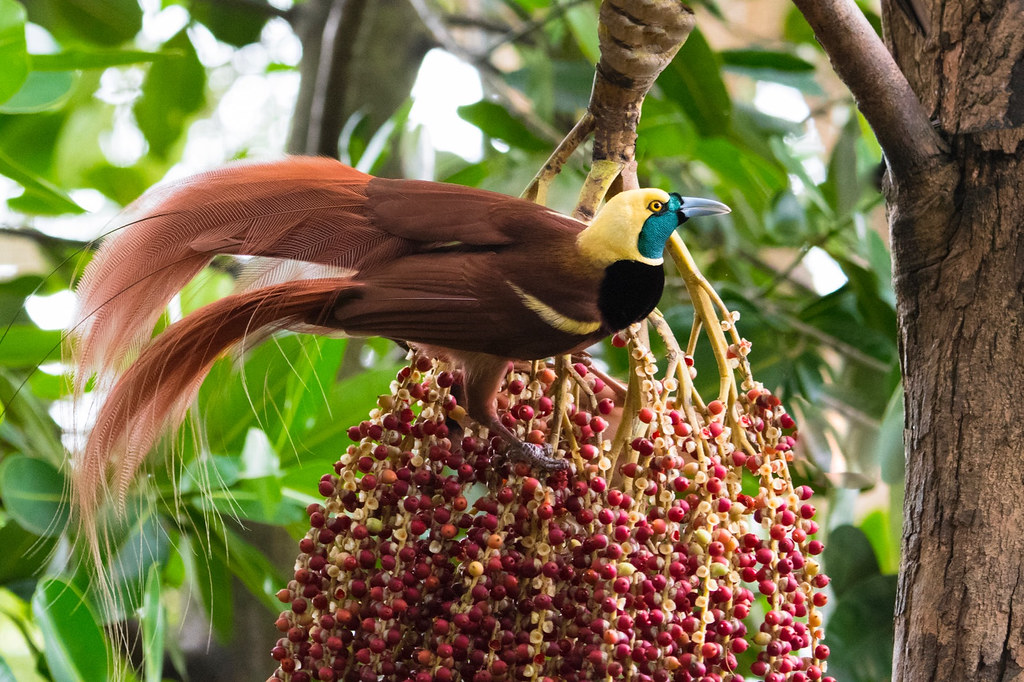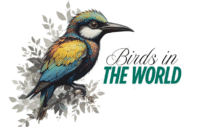The Raggiana Bird-of-Paradise, a radiant bird adorned with crimson plumes, an emerald throat, and golden sprays, fills Papua New Guinea’s rainforests with its vibrant “wak-wak” calls and mesmerizing courtship dances. Native to the lowland forests of the mainland, this plumed songster performs in communal leks, captivating onlookers with its exuberant displays. As Papua New Guinea’s national emblem, the Raggiana Bird symbolizes the region’s rich biodiversity, though its habitat faces growing threats. This article explores the Raggiana Bird-of-Paradise’s stunning vocalizations, ecological role, cultural significance, and conservation challenges, celebrating its role as a rainforest icon.

The Enchanting Voice of the Crimson Raggiana Bird-of-Paradise
Vibrant Courtship Calls
The Raggiana Bird-of-Paradise is renowned for its sharp, rhythmic “wak-wak” calls, punctuated by softer whistles, which echo through the rainforest during lek displays. Males gather in groups to vocalize and dance, their calls signaling vigor to attract females. For example, their loud, repetitive chants create a symphony that resonates across the canopy. This crimson performer’s vocal prowess, as explored in our Bird Songs and Calls category, makes it a standout in Papua New Guinea’s auditory landscape.
Rainforest Acoustic Havens
The Raggiana Bird-of-Paradise thrives in the dense, humid lowland rainforests of Papua New Guinea, where tall trees and thick foliage amplify its calls. These environments, found in regions like the Sepik Basin, provide ideal acoustics for lek performances. However, logging and agriculture encroach on these habitats, muffling the plumed songster’s voice. Its reliance on pristine forests, highlighted in our Birds by Region category, underscores the need to protect Papua New Guinea’s rainforest soundscapes.
Behavior and Ecology of the Rainforest Raggiana Bird-of-Paradise
Lek Displays and Dance Rituals
The Raggiana Bird is celebrated for its elaborate lek displays, where males perch on branches, fluff their crimson plumes, and perform synchronized dances with wing-flapping and head-bobbing. Their vocalizations intensify during these rituals, signaling dominance. For instance, deeper, louder calls often attract more females, ensuring mating success. These performances, detailed in our Bird Songs and Calls category, position the Raggiana Bird-of-Paradise as a master of rainforest theatrics.
Frugivorous Diet and Seed Dispersal
As a frugivore, the Raggiana Bird-of-Paradise feeds primarily on fruits like figs and berries, occasionally supplementing with insects. Its feeding habits disperse seeds, promoting rainforest regeneration and supporting biodiversity. As a result, its ecological role is vital, yet deforestation limits fruit availability. The rainforest jewel’s diet ties it to the health of Papua New Guinea’s forests, making its vocal presence a barometer of ecosystem vitality.
Cultural Significance of the Plumed Raggiana Bird-of-Paradise
Indigenous Symbolism and Rituals
The Raggiana Bird-of-Paradise, known locally as “kumul,” holds deep cultural significance in Papua New Guinea, where its crimson and gold plumes adorn traditional headdresses and ceremonial attire. Highland tribes, such as the Huli, view its beauty and calls as symbols of prosperity and strength. The plumed songster’s vibrant calls connect Papua New Guinea’s people to their ancestral heritage.
A National and Ecotourism Icon
The Raggiana Bird-of-Paradise serves as Papua New Guinea’s national emblem, featured on flags, currency, and tourism campaigns. Its lek displays draw ecotourists to sites like Varirata National Park, boosting local economies. Moreover, its calls feature in cultural festivals and documentaries, blending nature with national pride. The crimson performer’s allure fuels efforts to promote Papua New Guinea as a global biodiversity destination, captivating international visitors.
Ecological Role of the Vibrant Raggiana Bird-of-Paradise
Supporting Rainforest Regeneration
The Raggiana Bird-of-Paradise plays a crucial role in rainforest ecosystems by dispersing seeds from the fruits it consumes, fostering new tree growth. This process supports a diverse array of wildlife, from orchids to mammals. For example, its feeding habits help maintain the dense canopies that define lowland forests.
Interactions with Forest Species
In its rainforest habitat, the Raggiana Bird competes with other frugivores, like hornbills, for fruit, using its loud calls to assert dominance at feeding sites. Its vibrant plumes also attract predators like hawks, requiring vigilant perching. For instance, its strategic lek placements high in the canopy minimize risks. These interactions reveal the Raggiana Bird-of-Paradise’s dynamic role in Papua New Guinea’s complex rainforest ecosystem.
Conservation Challenges for the Crimson Raggiana Bird-of-Paradise
Threats from Deforestation
The Raggiana Bird-of-Paradise faces significant threats from deforestation, driven by logging, palm oil plantations, and mining in Papua New Guinea. These activities fragment lek sites, silencing the plumed songster’s calls. As noted by World Wide Fund for Nature, habitat loss endangers many rainforest species. Protecting lowland forests is essential to ensure the Raggiana Bird continues to enchant Papua New Guinea’s landscapes.
Community and Global Conservation Efforts
Papua New Guinea’s conservation initiatives offer hope for the Raggiana Bird-of-Paradise, with community-led programs protecting forests through sustainable land use and ecotourism. International partnerships support reforestation and anti-logging efforts, preserving lek habitats. Furthermore, local schools educate youth about the rainforest jewel’s plight, fostering stewardship.
Why the Raggiana Bird-of-Paradise Captivates Papua New Guinea
The Raggiana Bird-of-Paradise, with its crimson plumes, vibrant calls, and mesmerizing dances, embodies the wild spirit of Papua New Guinea’s rainforests. Its ecological contributions, cultural resonance, and ecotourism appeal make it a cherished national icon, yet its future depends on robust conservation. From indigenous rituals to global admiration, this bird weaves a vibrant narrative through Papua New Guinea’s identity. In conclusion, the Raggiana Bird inspires us to safeguard rainforest ecosystems, ensuring its plumed splendor endures. Have you heard the Raggiana Bird’s calls or seen its dances in person or online? Share your story in the comments and join our community of bird lovers!
